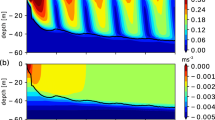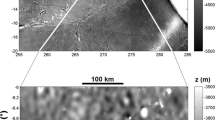Abstract
The dependence of the variation in the depth of the upper mixed layer (MLD) on the governing parameters (the momentum flux, the buoyancy fluxes at the ocean surface, and the density gradient in the pycnocline) is considered. It is shown that, in the spring storm season, wind mixing dominates over convective mixing. In this case, the MLD is linearly correlated with the Ekman scale calculated from the friction velocity observed approximately 12 h before the measurement of the MLD.
Similar content being viewed by others
References
V. I. Kalatskii, Modeling Vertical Thermal Structure of the Active Ocean Layer (Gidrometeoizdat, Leningrad, 1978) [in Russian].
A. A. Kuznetsov, Upper Quasihomogeneous Layer of the North Atlantic (IOAN-VNIIGMI-MTsD, Obninsk, 1982) [in Russian].
I. D. Lozovatskii, S. M. Shapovalov, and E. Ruzhe, “Ageostrophic Dynamics of the Upper Layer of the Ocean: Measurements over Transatlantic Section along 53° N,” Okeanologiya 46(1), 5–13 (2006) [Oceanology 46, (1), 5–13 (2006)].
V. P. Tereshchenkov, S. M. Shapovalov, S. A. Dobrolyubov, and E. G. Morozov, “Cruise 9 of R/V Akademik Ioffe,” Okeanologiya 42(2), 315–318 (2002) [Oceanology 42 (2), 298–301 (2002)].
B. N. Filyushkin, “Thermal Characteristics of the Upper Water Layer in the Northern Part of the Pacific Ocean,” Okeanologicheskie Issledovaniya (Mezhduved. Geofiz. Komitet AN SSSR), No. 19, 22–69 (1968).
B. N. Filyushkin, N. A. Dianskii, and S. N. Moshonkin, “Determination of the Lower Boundary of the Upper Mixed Layer of the Ocean,” Okeanologiya 36(1), 133–137 (1996) [Oceanology 36 (1), 122–126 (1996)].
K. H. Bathen, “On the Seasonal Changes in the Depth of the Mixed Layer in the North Pacific Ocean,” J. Geophys. Res. 77, 7138–7150 (1972).
K. E. Brainerd and M. C. Gregg, “Surface Mixed and Mixing Layer Depths,” Deep-Sea Res. 42(9), 1521–1544 (1995).
R. X. Huang and S. Russell, “Ventilation of the Subtropical North Pacific,” J. Phys. Oceanogr. 24(12), 2589–2605 (1994).
A. B. Kara, P. A. Rochford, and H. E. Hurlburt, “An Optimal Definition for Ocean Mixed Layer Depth,” J. Geophys. Res. 105, 16803–16821 (2000).
K. A. Kelly and B. Qiu, “Heat Flux Estimates for the Western North Atlantic, I, Assimilation of Satellite Data Into a Mixed Layer Model,” J. Phys. Oceanogr. 25(10), 2344–2360 (1995).
P. J. Lamb, “On the Mixed Layer Climatology of the North and Tropical Atlantic,” Tellus Ser. A 36, 295–305 (1984).
S. J. Lentz, “The Surface Boundary Layer in Coastal Upwelling Regions,” J. Phys. Oceanogr. 22(12), 1517–1539 (1992).
S. Levitus, Climatological Atlas of the World Ocean, (NOAA Prof. Pap., Vol. 13, U.S. Govt. Print. Off., Washington, DC, 1982).
M. R. Lewis, M. Carr, G. Feldman, et al., “Influence of Penetrating Solar Radiation on the Heat Budget of the Equatorial Pacific Ocean,” Nature 347(6293), 543–544 (1990).
C. P. Lombardo and M. C. Gregg, “Similarity Scaling of Viscous and Thermal Dissipation in a Convecting Surface Boundary Layer,” J. Geophys. Res. 94, 6273–6284 (1989).
I. D. Lozovatsky, A. L. Berestov, and A. S. Ksenofontov, “Phillips Theory of Turbulence-Generated Fine Structure: Numerical and Stochastic Modelin,” in Abstracts of John Hopkins Conference in Environmental Fluid Mechanics, Baltimore MD, 1998), pp. 102–103.
R. Lukas and E. Lindstrom, “The Mixed Layer of the Western Equatorial Pacific,” J. Geophys. Res. 96(Suppl. S), 3343–3357 (1991).
P. J. Martin, “Simulation of Mixed Layer at OWS November and Papa with Several Models,” J. Geophys. Res. 90(C1), 903–916 (1985).
J. R. Miller, “The Salinity Effect in a Mixed Layer Ocean Model,” J. Phys. Oceanogr. 6(1), 29–35 (1976).
G. Monterey and S. Levitus, Seasonal Variability of Mixed Layer Depth for the World Ocean (NOAA Atlas NES-DIS, Vol. 14, U.S. Govt. Print. Off., Washington, DC, 1997).
P. P. Niiler and E. B. Kraus, Modeling and Prediction of the Upper Layers of the Ocean, Ed. by E. B. Kraus (Pergamon, New York, 1977), pp. 143–172.
A. Obata, J. Ishazaka, and M. Endoh, “Global Verification of Critical Depth Theory for Phytoplankton Bloom with Climatological in situ Temperature and Satellite Ocean Color Data,” J. Geophys. Res. 101, 20657–20667 (1996).
L. Padman and T. M. Dillon, “Turbulent Mixing Near the Yermak Plateau during the Coordinate Eastern Arctic Experiment,” J. Geophys. Res. 96, 4769–4782 (1991).
H. Peters, M. C. Gregg, and J. M. Tool, “Meridional Variability of Turbulence Through the Equatorial Undercurrent,” J. Geophys. Res. 94, 18003–18009 (1989).
R. T. Pollard, P. B. Rhines, and O. R. Y. Thompson, “The Deepening of the Wind-Mixed Layer,” Geophys. Fluid Dynamics 3(4), 381–404 (1973).
J. E. Price, R. A. Weller, and R. Pinkel, “Diurnal Cycling: Observations and Models on the Upper Ocean Response to Diurnal Heating, Cooling, and Wind Mixing,” J. Geophys. Res. 91, 8411–8427 (1986).
P. Qu, “Mixed Layer Heat Balance in the Western North Pacific,” J. Geophys. Res. 108(3242), 35-1–35-13 (2003) [doi:10.1029/2002JC0015326].
K. J. Richards, M. E. Inall, and N. C. Wells, “The Diurnal Mixed Layer and Upper-Ocean Heat Budget in the Western Equatorial Pacific,” J. Geophys. Res. 100(C4), 6865–6879 (1995).
N. Schneider and P. Muller, “The Meridional and Seasonal Structures of the Mixed-Layer Depth and Its Diurnal Amplitude Observed During the Hawaii-to-Tahiti Shuttle Experiment,” J. Phys. Oceanogr. 20(9), 1395–1404 (1990).
M. A. Spall, “A Diagnostic Study of the Wind-and Buoyancy-Driven North Atlantic Circulation,” J. Geophys. Res. 96(C10), 18509–18518 (1991).
R. Thomspon, “Climatological Numerical Models of the Surface Mixed Layer of the Ocean,” J. Phys. Oceanogr. 6(4), 496–503 (1976).
R. G. Wagner, “Decadal Scale Trends in Mechanisms Controlling Meridional Sea Surface Temperature Gradients in the Tropical Atlantic,” J. Geophys. Res. 101(C7) 16683–16694 (1996).
G. L. Weatherly and P. L. Martin, “On the Structure and Dynamics of Oceanic Bottom Boundary-Layer,” J. Phys. Oceanogr. 8(4), 557–570 (1978).
S. S. Zilitinkevich and I. N. Esau, “On Integral Measures of the Neutral Barotropic Planetary Boundary Layer,” Boundary Layer Meteorol. 104(3), 371–379 (2002).
Author information
Authors and Affiliations
Additional information
Original Russian Text © I.D. Lozovatsky, S.M. Shapovalov, 2006, published in Okeanologiya, 2006, Vol. 46, No. 3, pp. 325–330.
Rights and permissions
About this article
Cite this article
Lozovatsky, I.D., Shapovalov, S.M. Parameterization of the depth of the upper quasi-homogeneous layer based on measurements in the North Atlantic (Section along 53° N). Oceanology 46, 299–304 (2006). https://doi.org/10.1134/S0001437006030015
Received:
Accepted:
Issue Date:
DOI: https://doi.org/10.1134/S0001437006030015




